100 Film Favorites – #30: WALL-E
(Andrew Stanton, 2008)
In today’s entry, Pixar does post-apocalyptic.
I think I was in love with this movie from its opening instant. A shout of “Out there…” from Michael Crawford (the original Broadway “Phantom”) accompanies the sudden appearance of a spectacular stellar panorama. The song “Put On Your Sunday Clothes” from Hello, Dolly! plays as the camera zooms through space toward a curiously brownish Earth. Through a virtual crust of millions of satellites and assorted other space junk, we enter the atmosphere of Earth, which, to quote Dr. Seuss, has become “smoke-smuggered.” The world is desolate and covered with trash, and in many places pyramids composed of condensed garbage tower higher than the city skyscrapers.

These gargantuan trash-heaps are the handiwork of our protagonist, WALL-E. A tiny trash-compacting robot, WALL-E has toiled for seven centuries in the pursuit of his “directive” – namely, compacting and stacking trash. Though many WALL-E robots once shared the job of cleaning the abandoned Earth, over the intervening decades the others gradually broke down, one by one. “Our” WALL-E is the last survivor, as he has developed an unusually keen knack for self-preservation, salvaging replacement parts from his fallen companions. This peculiarity is shown to be part of an emerging sentience: WALL-E is curious, collecting a variety of interesting trinkets from human society’s past.
Snippets of old advertisements reveal that humans abandoned the Earth aboard a fleet of starships, and left the WALL-E squadrons behind to clean up their mess. At least one of these ships, the Axiom, routinely sends probe robots to Earth to check for signs of returning life on the planet’s surface. One day, WALL-E encounters such a probe, who identifies herself as EVE. Inspired by the romances depicted in his favorite films, the lonely WALL-E quickly falls for EVE. EVE, on the other hand, exhibits a (fittingly) robotic lack of emotion, and remains dedicated to fulfilling her own directive. When she spies a tiny (but living) sapling among WALL-E’s collection of cultural ephemera, EVE snatches the plant, stores it within herself, and powers down, awaiting retrieval. The surprised WALL-E dotes on the dormant robot, protecting EVE from Earth’s frequent sandstorms and hitching a ride on the spacecraft which eventually comes to collect her.
The craft returns to the Axiom, a behemoth which resembles nothing so much as an interstellar cruise ship. The ship’s human passengers have devolved over the centuries into obese, balloonish blobs, due both to extended exposure to the microgravity of space and to the fact that, aboard the Axiom, all daily activities are performed for the humans automatically by a vast array of robotic servants and other machines.
Into this dystopian scenario of endless sameness and monotony drops the very atypical WALL-E. From the moment he arrives on the ship, WALL-E profoundly influences almost everyone he interacts with. As he rolls throughout the ship, WALL-E haplessly bumps into both people and robots as they zoom along on their pre-programmed paths. Disrupted by our rusty Romeo, the other robots are forced to compute situations previously unaccounted for, and the equally routine-driven humans begin for the first time to notice and experience their physical surroundings. The Axiom’s captain, the one human member of the otherwise robotic crew, develops curiosity of his own, and begins investigating the history of the Earth, its culture, and his mission. Even EVE has an awakening of her own, as she gradually begins to appreciate WALL-E’s creative and caring nature.
The ship’s autopilot, an artificial intelligence named AUTO, takes umbrage with WALL-E’s antics. Instructed by its superiors (the massive Wal-Mart-like “Buy-n’-Large” corporation, which ran both the economy and government of the old world) that Earth is emphatically uninhabitable and the ship must not return there, AUTO repeatedly obstructs WALL-E and EVE’s efforts to place the plant within a receptor on the ship’s bridge, which will trigger the Axiom’s immediate return to Earth. The duo nearly deliver their botanical payload, but AUTO simply lowers the receptor console into the floor, critically squashing WALL-E.
The compactor has become the compactee, and things look bleak. The ship’s captain, having educated himself about Earth’s former glory, is thoroughly fed up with the current state of affairs, with humanity round and our protagonist flat. To the strains of “Also Sprach Zarathustra,” the iconic opening music from 2001: A Space Odyssey, the captain stands on his own two feet, and, after an intense grappling session, is able to overpower AUTO. EVE places the plant in the console and the ship zips back to Earth.
While the flabby humans stagger out onto Earth’s surprisingly non-green surface, EVE frantically searches WALL-E’s museum-hut for the necessary parts to repair the grievously injured robot. She succeeds, but when WALL-E reboots, he is apparently restored to his original status as a “proper” robot, interested only in his directive as a trash compactor. EVE, now fully sentient, is heartbroken.
She sadly “kisses” him, and the spark jolts WALL-E back to his curious, loving self. A montage over the ending credits show WALL-E and EVE working hand in hand with the captain, the humans, and the other robots to slowly restore the scarred Earth to a world of green and plenty.
It’s easy to dismiss WALL-E as being “too preachy” due to its perceived environmentalist message. However, I think it’s interesting to note that, sticking up among the heaps of trash in the opening shot, we see not only smokestacks, but also numerous wind turbines and the funnels of nuclear plants. Before the world “ended,” people obviously explored and exploited an assortment of different energy sources. While the film is obviously critical of the wasteful and polluting lifestyle characteristic of massive, blind consumerism, I think “blind” is the operative word.
In my opinion, this is a movie about the importance of awakening to our humanity. The humans’ greatest crime wasn’t pollution or consumerism, but rather becoming so insular, self-serving, and complacent that they simply forgot about other people and the physical world around them. This is a trend we can readily see at work in our own lives. In director Andrew Stanton’s words, “we all fall into our habits, our routines and our ruts, consciously or unconsciously, to avoid living. To avoid having to do the messy part…dealing with the person next to us. To avoid having relationships with other people.” But, as Stanton also notes, love and its irrationality “defeat life’s programming.” WALL-E’s love, both for EVE and simply for learning, differentiate him from his fellow compactor units and allow him to endure. This love and the creative, adventurous spirit it inspires is infectious, and awakens a similar spirit in the people with whom WALL-E interacts, inspiring them to break out of the “mechanical” ruts into which they have allowed themselves to gravitate.
WALL-E’s journey even challenges other robots to break free from the strictures of their programming. For instance, a cleaning robot accustomed to traveling a straight path is baffled when his directive drives him to clean WALL-E’s dirty trail…even though said trail curves away from his programmed route. The cleaner ultimately decides to deviate from the path. Hopping dramatically off the grid, the tiny robot realizes nothing bad has happened, and merrily follows WALLE’s sidewinding trail of filth.
So is the film’s message that technology is the enemy of humanity, consigning us to a rote, mechanical “lifestyle?” Rather, I think the final “rebuilding” sequence suggests that technology is a useful tool which can greatly increase the effectiveness of man’s labor – but it must not be used to ends which supersede the human desires to interact with one another and produce useful and beautiful things. It is these desires, the film argues, which are what make us truly human, and protect us from becoming mindless (and flabby) robots.
Though I do still kind of want a “Septuacentennial Cupcake-in-a-Cup.”
One of the greatest triumphs of WALL-E is its soundscape. Virtually all sound-effects in the film, including the “voices” of the many robot characters, were created by Star Wars sound designer Ben Burtt. Burtt, who had previously engineered the notably expressive burbles of another iconic film robot, R2-D2, built upon that experience in what was to be his largest project to date. Burtt worked for years manipulating a vast assortment of foley (studio-recorded), found, and digital sounds to build characters from the ground up. I don’t normally rant about “Oscar snubs,” but the fact that Ben didn’t win for Sound Editing OR Sound Design is a crime. I don’t care how cool an explosion in The Dark Knight sounds. When that explosion starts expressing emotion, and carrying the entire first act of a film virtually by itself, then maybe we can talk.
Speaking of that first act, it’s truly a credit also to the skill of the Pixar animators. The artists carefully studied the performances of silent comedy stars Charlie Chaplin and Buster Keaton, and the influence shows. These performers demonstrated how richly emotion can be conveyed without a single word being spoken aloud. Keaton, the “Great Stone Face,” was especially influential, as he showed how much emotion can be conveyed solely by the eyes and body movement – the only tools WALL-E has at his disposal. Notice that he has no nose or mouth, but still conveys his feelings and desires flawlessly. With Burtt’s audio and the animators’ visuals, the sequence is a true masterwork of contemporary nonverbal storytelling.
This became the longest post to date quite a while back, but I still have two final comments to make:
1. This film contains a fair bit of biblical symbolism. The Axiom is a celestial Noah’s Ark, preserving what’s left of humanity aboard a ship while the world perishes. After a lengthy journey, a probe is sent to acquire a sample of plant life to determine whether return is possible…just as Noah sends a dove, which returns with an olive branch to signify that the waters have receded. In addition to this dove parallel, EVE can also be compared to her namesake. Like the biblical Eve, she is delivered from above as a companion to “first man” WALL-E in his loneliness.
2. Since we’re on the topic of literary parallels: I saw a lot of potential connections between this film and One Flew Over the Cuckoo’s Nest. Like WALL-E, McMurphy, that story’s protagonist, encourages the people around him (the inmates of an insane asylum) to free themselves from oppressive, mechanical routine. In one scene, WALL-E even frees the inhabitants of the “defective” robot ward, the equivalent of a robot asylum. At the end of McMurphy’s story, the domineering Nurse Ratched orders him lobotomized. But McMurphy’s influence endures, and the patients are now beyond Ratched’s control, with one inmate finally realizing the power within himself, smothering McMurphy’s sorry husk, and ultimately escaping the asylum. I thought “WALL-E” might actually be going this route. AUTO smashes WALL-E, who is restored to life, but in a “brainless” state. I honestly thought the film might leave him that way, and end with EVE deeply saddened, but now fully alive. Knowing that WALL-E must live on through the continuing of his work, EVE sets about awakening human and robot alike to the power of their spirits and the agency of their bodies. I still like the “happy ending” they came up with, but I think mine’s good too.
Finally, for some last minute multimedia shenanigans, here’s an impressive tribute to robo-centric films throughout the ages. It’s “Where’s WALL-E?” Just see how many of these robot characters from movies and television you can name…oh, and try to find today’s protagonist amidst the crowd (click the image for a larger view):
—
Brian Terrill is the host of television show Count Gauntly’s Horrors from the Public Domain. You can keep up with Brian’s 100 Film Favorites countdown here.




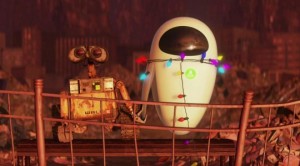

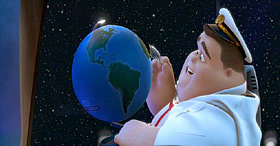
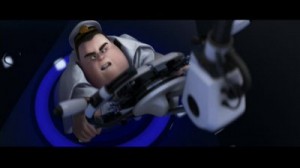
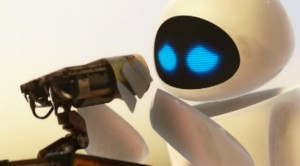

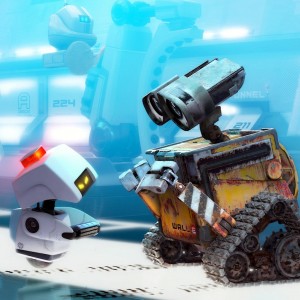

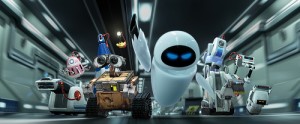




That the demon limelight of celebrity ostensibly didn’t kill this one —
that the flame merely died out on its own — makes it almost sadder.
Pingback: Progression is Regression – Essence of Humanity